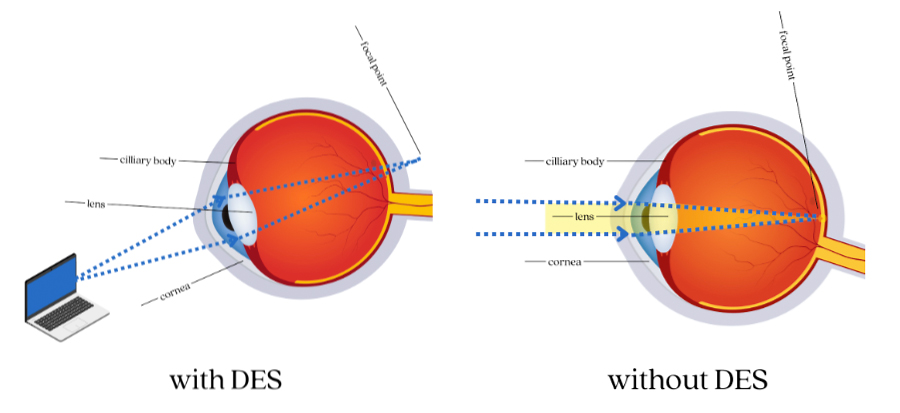

It’s no surprise that today’s visual demands are different since the pandemic. Most adults are looking at screens at closer distances. In fact, the average amount of screen time for adults has increased from 7 hours to over 11 hours per day! Many experience rapid focus changes (the rate at which a person looks between different devices) throughout the day which forces the muscles in your eye to also act quickly to accommodate.
Digital Eye Strain (DES) is defined as a group of eye and vision related problems that result from prolonged use of digital devices. Symptoms include headache, blurry vision, dry eyes, neck and shoulder pain, and poor night vision. This is caused by multiple factors like the glare on digital screens, improper viewing distance, poor ergonomics, or previously uncorrected vision problems.
Why does DES occur? When light comes into the eye, it should focus on the retina, located at the back of the eye. The ciliary muscles which help hold the lens in place are relaxed and the light focuses right where it’s supposed to. However, if we are constantly changing our focal point, the ciliary muscles get fatigued to the point that they spasm or lock up. By the end of the day, these muscles still haven’t relaxed so it’s even harder to focus which leads to that afternoon or post 5pm feeling of fatigue, headaches, and blurry vision.

You may have noticed that the symptoms of DES are surprisingly similar to the symptoms of presbyopia. Let’s not forget that presbyopia is the decline or loss of the len’s ability to focus on objects at close distances. This is a natural aging of the lens and cannot be cured. This is not the same as DES, which is the onset of bothersome symptoms from the overuse of the focusing muscle within the eye.
You might have heard the term “anti-fatigue lenses” before and this is a great option for those with DES symptoms. DES patients can have perfect or near perfect vision that just need support while using digital devices for prolonged periods of time. These lenses feature a small boost of magnification near the bottom of the lens that lessens eye strain by pushing the focal point back to the retina where it belongs. It’s considered a single vision lens and can come with or without a blue light coating. Studies have shown that younger adults who use anti-fatigue lenses can slow the onset of presbyopia in later years.
When reading glasses are worn as a treatment for presbyopia, these lenses are one general strength magnification that provides a stronger overall power for seeing up close and intermediate distances due to the lens inability to focus. Presbyopic patients don’t have perfect vision and need readers to see images at a near distance during the span of their day (if you know, you know).
It can be hard to know which vision issue is causing you so much discomfort at the end of a long day. That’s why eye exams and getting into the routine of annual checkups are so vital to your eye health. The treatment for presbyopic patients would not necessarily be the same treatment for someone suffering from DES. Your eyecare professional might give you a questionnaire asking about your symptoms and how many hours per day you use a smart phone or desktop computer, or how much time you spend outside.
Whether you think you have DES or presbyopia, getting an eye exam is always the best solution!